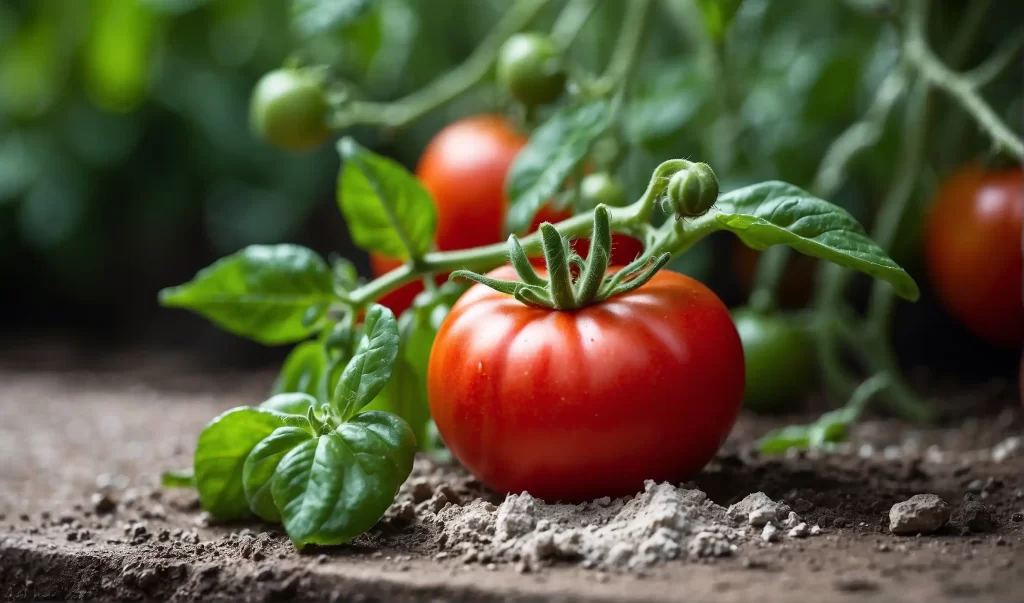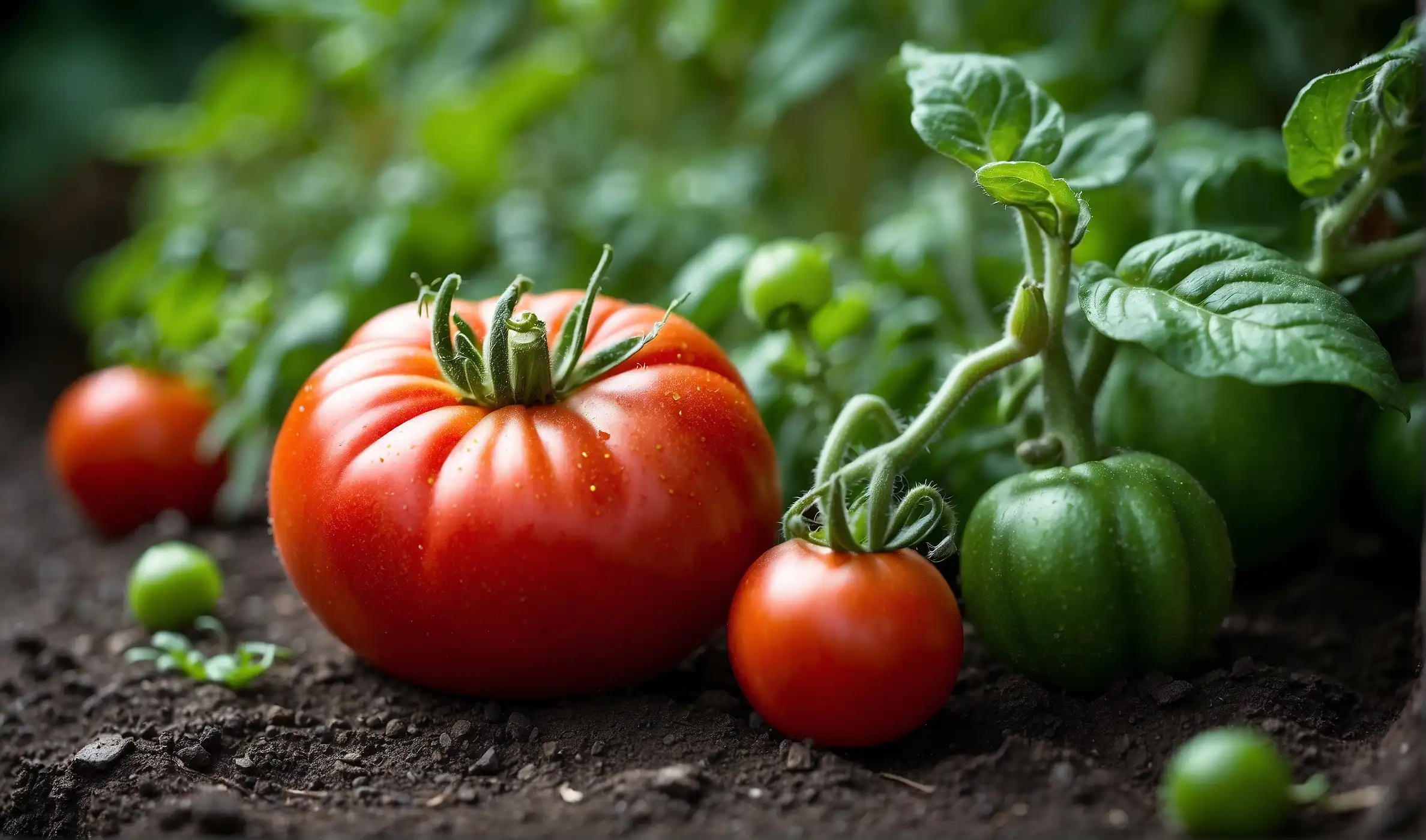Apply approximately 1 cup of gypsum per tomato plant to improve soil structure and calcium levels. Distribute it evenly in the soil around the plant base.
Gardeners seeking to enhance their tomato crop yields can benefit significantly from the judicious use of gypsum. This soil amendment plays a crucial role in preventing blossom end rot by supplying calcium without altering the soil pH. It also helps in loosifying compacted soil, allowing for better root growth and water penetration.
Given that tomatoes are particularly sensitive to calcium deficiencies, gypsum serves as an excellent supplement to ensure a healthy, robust harvest. By incorporating this nutrient-rich mineral into your gardening routine, you ensure your tomato plants have the support they need right from the start.
Understanding Gypsum’s Role For Tomatoes
Gypsum, a mineral composed of calcium sulfate, is often used in gardening and agriculture as a soil amendment. It serves as an excellent source of calcium and sulfur for plants, which are vital nutrients for the growth of healthy tomatoes. When applied to soil, gypsum helps to decrease soil compaction, facilitating better water penetration and root development.

For tomato plants, gypsum’s application can lead to enhanced growth and improved yield by assisting in the regulation of soil salinity and replenishment of essential nutrients. This soil amendment counters excess sodium in the soil, promoting soil structure improvement which is particularly beneficial for clay soils. The use of gypsum can also aid in preventing common tomato plant ailments, such as blossom end rot, which is often caused by a calcium deficiency.
Diagnosing Tomato Plant Needs
Tomato plants thrive when an optimal nutrient balance is maintained in the soil. A key nutrient, calcium, plays a pivotal role in the development of healthy plant structures and helps in preventing blossom-end rot, a common issue in tomatoes. To identify calcium deficiency, observe the plant’s leaves for curling, abnormal growth patterns, or a general stunted growth. The fruit itself may display signs such as blackened areas at the bottom, indicating insufficient calcium uptake.
The introduction of gypsum (calcium sulfate) can help amend the soil, providing the much-needed calcium without altering the soil pH significantly. This is crucial as fluctuating pH levels can affect the absorption of other nutrients. A measured approach to adding gypsum will ensure tomato plants get the right amount of calcium, promoting healthy growth and a bountiful harvest.
How Much Gypsum For Your Tomato Plant
The amount of gypsum needed for each tomato plant can vary based on a range of factors. Ideal application rates depend on soil composition, level of soil compaction, and the plant’s specific needs. Soil testing is highly recommended to determine the exact needs of your garden.
Gypsum works to improve soil structure, promoting better water penetration and root development. It is essential for gardens with heavy clay soils or soils with high levels of sodium, which can lead to compacted conditions. A general recommendation for vegetable gardens is to apply about 1 pound of gypsum per 10 square feet.
Considering that most tomato plants require approximately 2-4 square feet of space, the amount of gypsum may range from 0.2 to 0.4 pounds per plant. These figures serve as a baseline; actual needs could be higher in soils with severe deficiencies.
| Soil Type | Tomato Plants Spacing | Gypsum Requirement |
|---|---|---|
| Heavy Clay | 2-4 square feet/plant | 0.2-0.4 pounds/plant |
| Sodium-rich Soil | 2-4 square feet/plant | Adjust according to soil test |
Implementing Gypsum In Tomato Cultivation
Successful tomato cultivation often involves incorporating gypsum to enhance soil structure and provide essential nutrients. To ensure optimal growth, distribute gypsum evenly across the soil before planting tomatoes. Aim for a rate of roughly 2-3 pounds of gypsum for each tomato plant. This process begins with loosening the soil, usually to a depth of about 6-8 inches, where the roots predominantly grow.
After loosening, spread the gypsum evenly and work it into the soil, ensuring proper integration. Avoiding clumps or uneven distribution is key for consistent nutrient availability. The gypsum should ideally be mixed with the top layer of soil, facilitating easy access for the developing roots. Watering immediately after application helps in the dissolution of gypsum, thereby enabling it to release calcium and sulfur.
Timing And Frequency Of Gypsum Applications
Optimal periods for gypsum application revolve around the plant’s growth cycle and soil conditions. For tomato plants, it is crucial to apply gypsum before planting to prepare the soil. A second application should be considered during the flowering stage to support fruit development. Seasonal factors significantly influence gypsum use. In regions with heavy rainfall, more frequent applications may be necessary due to gypsum leaching. Conversely, in dryer climates, less frequent applications are often adequate.
As temperatures rise in the spring and summer, gypsum helps to mitigate soil compaction caused by watering and supports the plant’s need for calcium during periods of intense growth. It is less effective during cold weather when plant growth slows down and calcium uptake is reduced. Thus, timing gypsum applications with these growth and seasonal patterns can lead to healthier plants and improved yields.
Monitoring Soil Conditions Post-gypsum
Assessing the impact of gypsum on soil pH requires diligent observation and testing. Regular soil testing, both before and after the application of gypsum, is paramount to understanding its effects. Gardeners should note that gypsum works to add calcium to the soil without altering pH levels significantly when used correctly. Consequently, an ideal pH range for tomato plants, typically between 6.0 to 6.8, should remain reasonably stable. Ensuring a consistent environment supports overall plant vitality and yield.
Techniques for tracking plant health improvements include consistent monitoring of physical attributes such as leaf color and fruit quality. Tracking alterations in plant growth patterns provides practical insight into the benefits of gypsum amendment. Simple notations on plant vigor and the presence of pests or diseases offer valuable information on the effectiveness of soil treatments. This empirical data, coupled with soil test results, guides future gypsum applications to foster robust tomato plants.
Additional Care For Gypsum-treated Tomatoes
Proper hydration is key for tomatoes grown in gypsum-amended soils. To ensure optimal moisture, implement a consistent watering routine, adjusting for rainfall and temperature changes. Gypsum improves water penetration, but overwatering can still lead to root issues. A balanced approach, typically 1-1.5 inches of water per week, will suffice.
Concerning fertilizer and pesticide use, tomatoes in gypsum-treated soil may require less nitrogen fertilizer. Gypsum adds calcium and sulphur, nutrients that support plant health and potentially reduce the need for certain pesticides. Nevertheless, tomatoes should be monitored for pests and diseases with intervention tailored to observed challenges, always aligning with eco-friendly practices to maintain soil integrity.
Troubleshooting Common Tomato Issues
Overapplication of gypsum can lead to several issues in tomato plants. One of the key problems is the potential for soil imbalance, where too much gypsum can lead to an excess of calcium at the expense of other vital nutrients. This imbalance can hinder plant growth and fruit production. To remedy overapplication, it’s essential to test your soil and possibly reduce gypsum usage in subsequent plantings.
Tomato plants suffering from nutrient deficiencies often display distinct symptoms such as yellow leaves or stunted growth. These issues often arise from a lack of key nutrients like nitrogen, phosphorus, or potassium. Providing a balanced fertilizer can help resolve these deficiencies. Continuous soil testing is recommended to monitor and adjust treatment plans for optimal tomato health.
FAQs Of How Much Gypsum Per Tomato Plant
How Much Gypsum For Each Tomato Plant?
A standard recommendation is applying approximately 1 cup of gypsum for each tomato plant. This helps improve soil structure, allowing for better water penetration and root growth. Distribute the gypsum evenly around the plant’s base and mix it into the soil.
When To Apply Gypsum To Tomato Plants?
Gypsum should be applied to tomato plants either before planting or during the growing season. For pre-planting, it’s mixed into the soil before you plant the tomatoes. If used during the growing season, it can be applied around existing plants and watered in.
Can Gypsum Benefit Tomato Plant Growth?
Yes, gypsum can benefit tomato plant growth. It provides a source of calcium and sulfur, which are essential nutrients for tomatoes. It helps prevent blossom-end rot and promotes healthy plant development by improving soil structure and nutrient uptake.
Does Gypsum Improve Tomato Soil Quality?
Gypsum improves tomato soil quality by adding calcium without altering soil pH. It helps to loosen clay soils and provides aeration, allowing roots to grow deeply. It also enhances water infiltration, preventing soil compaction and salinity issues.
Conclusion
As we wrap up, remember the right amount of gypsum can work wonders for your tomato plants. Typically, a handful per plant ensures healthy growth and bountiful yields. Always consider your soil’s specific needs and adjust accordingly.
Tomato farming starts with selecting the right variety; at Farm Pioneer, we delve into the best types suited for different climates and soils. Happy gardening and may your tomatoes flourish!
